通信网基本概念与主体结构答案
- 格式:doc
- 大小:35.50 KB
- 文档页数:4
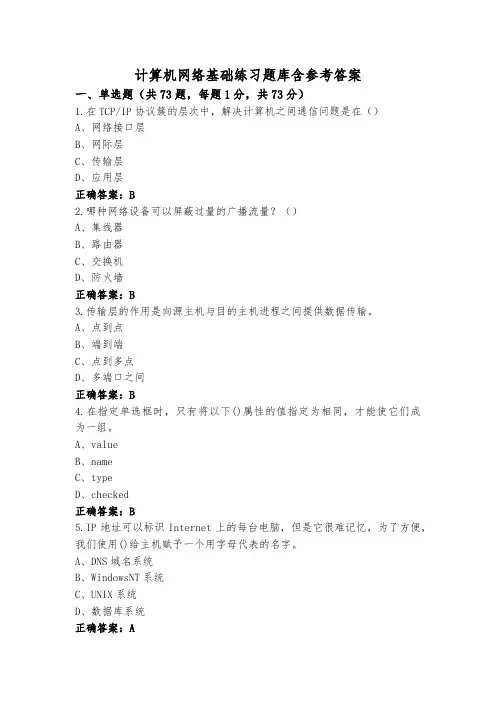
计算机网络基础练习题库含参考答案一、单选题(共73题,每题1分,共73分)1.在TCP/IP协议簇的层次中,解决计算机之间通信问题是在()A、网络接口层B、网际层C、传输层D、应用层正确答案:B2.哪种网络设备可以屏蔽过量的广播流量?()A、集线器B、路由器C、交换机D、防火墙正确答案:B3.传输层的作用是向源主机与目的主机进程之间提供数据传输。
A、点到点B、端到端C、点到多点D、多端口之间正确答案:B4.在指定单选框时,只有将以下()属性的值指定为相同,才能使它们成为一组。
A、valueB、nameC、typeD、checked正确答案:B5.IP地址可以标识Internet上的每台电脑,但是它很难记忆,为了方便,我们使用()给主机赋予一个用字母代表的名字。
A、DNS域名系统B、WindowsNT系统C、UNIX系统D、数据库系统正确答案:A6.路由器的缺点是()。
A、无法进行流量控制B、无法隔离广播C、成为网络瓶颈D、不能进行局域网联接正确答案:C7.以下属于低层协议的是()。
A、FTPB、IPC、UDPD、TCP正确答案:B8.以下不属于应用层协议的是()A、TELNETB、SNMPC、HTTPD、RIP正确答案:D9.在对OSI参考模型中,自下而上第一个提供端-端服务的层次是。
A、数据链路层B、传输层C、网络层D、物理层正确答案:B10.在TCP/IP协议配置好后,Ipconfig命令显示的结果不包括下列_______。
A、本机IP地址。
B、网关的IP地址C、子网掩码D、DNS服务器地址正确答案:D11."WWW最初是由_____实验室研制的。
A、CERNB、AT&TC、ARPAD、MicrosoftInternetLab"正确答案:C12.关于虚拟局域网特征的描述中,错误的是。
A、虚拟局域网是建立在局域网交换技术基础上的。
B、逻辑工作组的节点组成不受物理位置的限制。

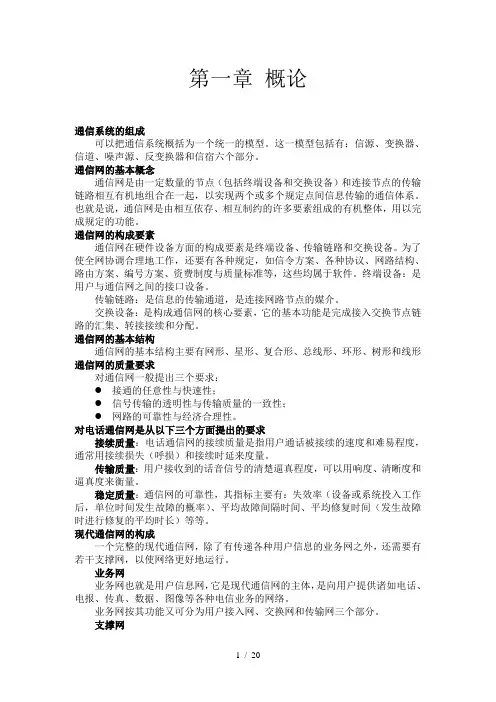
第一章概论通信系统的组成可以把通信系统概括为一个统一的模型。
这一模型包括有:信源、变换器、信道、噪声源、反变换器和信宿六个部分。
通信网的基本概念通信网是由一定数量的节点(包括终端设备和交换设备)和连接节点的传输链路相互有机地组合在一起,以实现两个或多个规定点间信息传输的通信体系。
也就是说,通信网是由相互依存、相互制约的许多要素组成的有机整体,用以完成规定的功能。
通信网的构成要素通信网在硬件设备方面的构成要素是终端设备、传输链路和交换设备。
为了使全网协调合理地工作,还要有各种规定,如信令方案、各种协议、网路结构、路由方案、编号方案、资费制度与质量标准等,这些均属于软件。
终端设备:是用户与通信网之间的接口设备。
传输链路:是信息的传输通道,是连接网路节点的媒介。
交换设备:是构成通信网的核心要素,它的基本功能是完成接入交换节点链路的汇集、转接接续和分配。
通信网的基本结构通信网的基本结构主要有网形、星形、复合形、总线形、环形、树形和线形通信网的质量要求对通信网一般提出三个要求:●接通的任意性与快速性;●信号传输的透明性与传输质量的一致性;●网路的可靠性与经济合理性。
对电话通信网是从以下三个方面提出的要求接续质量:电话通信网的接续质量是指用户通话被接续的速度和难易程度,通常用接续损失(呼损)和接续时延来度量。
传输质量:用户接收到的话音信号的清楚逼真程度,可以用响度、清晰度和逼真度来衡量。
稳定质量:通信网的可靠性,其指标主要有:失效率(设备或系统投入工作后,单位时间发生故障的概率)、平均故障间隔时间、平均修复时间(发生故障时进行修复的平均时长)等等。
现代通信网的构成一个完整的现代通信网,除了有传递各种用户信息的业务网之外,还需要有若干支撑网,以使网络更好地运行。
业务网业务网也就是用户信息网,它是现代通信网的主体,是向用户提供诸如电话、电报、传真、数据、图像等各种电信业务的网络。
业务网按其功能又可分为用户接入网、交换网和传输网三个部分。
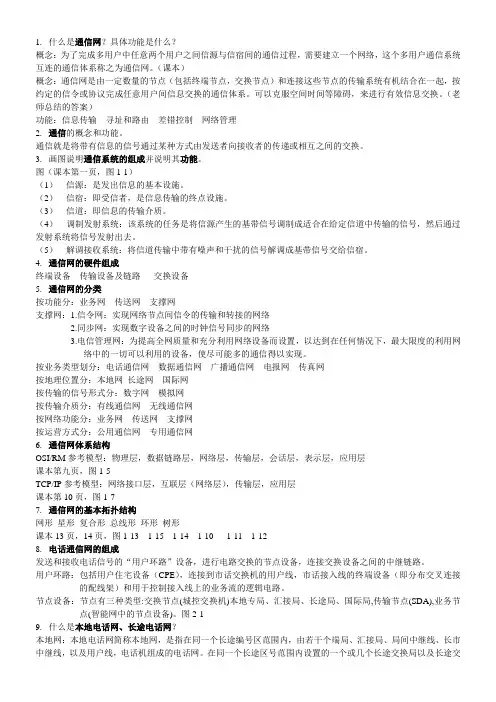
1. 什么是通信网?具体功能是什么?概念:为了完成多用户中任意两个用户之间信源与信宿间的通信过程,需要建立一个网络,这个多用户通信系统互连的通信体系称之为通信网。
(课本)概念:通信网是由一定数量的节点(包括终端节点,交换节点)和连接这些节点的传输系统有机结合在一起,按约定的信令或协议完成任意用户间信息交换的通信体系。
可以克服空间时间等障碍,来进行有效信息交换。
(老师总结的答案)功能:信息传输寻址和路由差错控制网络管理2. 通信的概念和功能。
通信就是将带有信息的信号通过某种方式由发送者向接收者的传递或相互之间的交换。
3. 画图说明通信系统的组成并说明其功能。
图(课本第一页,图1-1)(1)信源:是发出信息的基本设施。
(2)信宿:即受信者,是信息传输的终点设施。
(3)信道:即信息的传输介质。
(4)调制发射系统:该系统的任务是将信源产生的基带信号调制成适合在给定信道中传输的信号,然后通过发射系统将信号发射出去。
(5)解调接收系统:将信道传输中带有噪声和干扰的信号解调成基带信号交给信宿。
4. 通信网的硬件组成终端设备传输设备及链路交换设备5. 通信网的分类按功能分:业务网传送网支撑网支撑网:1.信令网:实现网络节点间信令的传输和转接的网络2.同步网:实现数字设备之间的时钟信号同步的网络3.电信管理网:为提高全网质量和充分利用网络设备而设置,以达到在任何情况下,最大限度的利用网络中的一切可以利用的设备,使尽可能多的通信得以实现。
按业务类型划分:电话通信网数据通信网广播通信网电报网传真网按地理位置分:本地网长途网国际网按传输的信号形式分:数字网模拟网按传输介质分:有线通信网无线通信网按网络功能分:业务网传送网支撑网按运营方式分:公用通信网专用通信网6. 通信网体系结构OSI/RM参考模型:物理层,数据链路层,网络层,传输层,会话层,表示层,应用层课本第九页,图1-5TCP/IP参考模型:网络接口层,互联层(网络层),传输层,应用层课本第10页,图1-77. 通信网的基本拓扑结构网形星形复合形总线形环形树形课本13页,14页,图1-13 1-15 1-14 1-10 1-11 1-128. 电话通信网的组成发送和接收电话信号的“用户环路”设备,进行电路交换的节点设备,连接交换设备之间的中继链路。
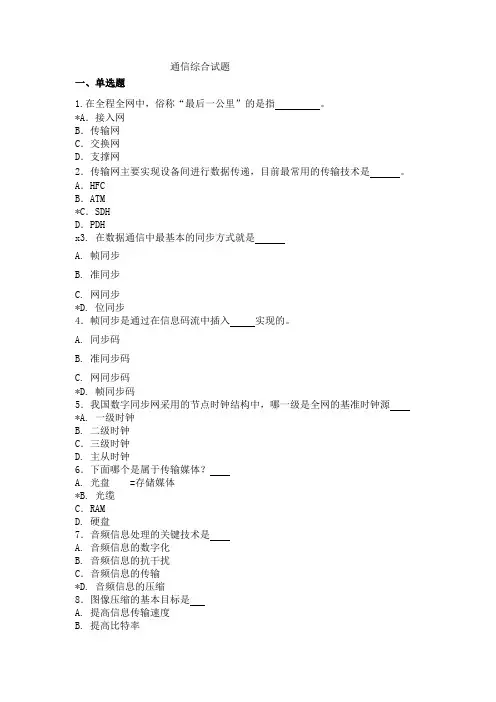
通信综合试题一、单选题1.在全程全网中,俗称“最后一公里”的是指。
*A.接入网B.传输网C.交换网D.支撑网2.传输网主要实现设备间进行数据传递,目前最常用的传输技术是。
A.HFCB.ATM*C.SDHD.PDHx3. 在数据通信中最基本的同步方式就是A. 帧同步B. 准同步C. 网同步*D. 位同步4.帧同步是通过在信息码流中插入实现的。
A. 同步码B. 准同步码C. 网同步码*D. 帧同步码5.我国数字同步网采用的节点时钟结构中,哪一级是全网的基准时钟源*A. 一级时钟B. 二级时钟C.三级时钟D. 主从时钟6.下面哪个是属于传输媒体?A. 光盘 =存储媒体*B. 光缆C.RAMD. 硬盘7.音频信息处理的关键技术是A. 音频信息的数字化B. 音频信息的抗干扰C.音频信息的传输*D. 音频信息的压缩8.图像压缩的基本目标是A. 提高信息传输速度B. 提高比特率*C.减小数据量D. 增加信道容量9.同步时分复用是指将时间划分为基本时间单位,1帧占用时长为。
A.100μs*B.125μsC.250μsD.25μs10.在整个光交换过程中,信号是以什么形式存在的?*A.光的形式B.电的形式C.光电转换的形式D.电光转换的形式11.下列哪些是无失真图像压缩编码方法A. 量化编码B. 混合编码C.子带编码*D. 游程编码12.电路交换网络中多采用传输。
*A. 恒比特率B. 变比特率C.高比特率D. 低比特率13.为了获得真实临场感,通信网络对语音和图像的传输时延都要*A. 小于0.25sB. 小于0.15msC.小于0.15sD. 小于0.25msx14.下列哪个不是基于网络层的多播A. 使用网络硬件提供的多播能力实现组通信B. 利用一对一进程间的通信机制实现C.使用网络广播机制实现D. 大量节约系统资源实现通信15. 网络使用路由协议建立多播树,其过程中多播源把数据或者广播通知发送给*A. 所有的路由器B. 同一网关路由器C.所有协调器节点D. 同一网关的协调器节点16.在ATM交换机中,广泛应用的交换网络是A.CLOS网络B.TST网络C.DSN网络*D.banyan网络17.下列哪些属于七层网络互联模型?一57 。
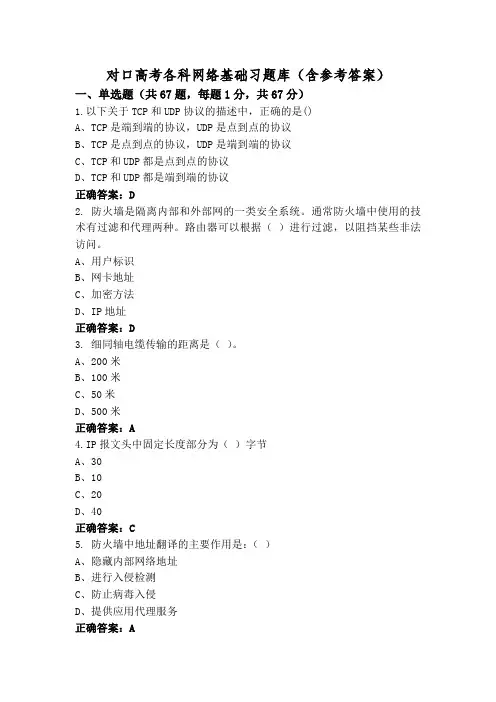
对口高考各科网络基础习题库(含参考答案)一、单选题(共67题,每题1分,共67分)1.以下关于TCP和UDP协议的描述中,正确的是()A、TCP是端到端的协议,UDP是点到点的协议B、TCP是点到点的协议,UDP是端到端的协议C、TCP和UDP都是点到点的协议D、TCP和UDP都是端到端的协议正确答案:D2. 防火墙是隔离内部和外部网的一类安全系统。
通常防火墙中使用的技术有过滤和代理两种。
路由器可以根据()进行过滤,以阻挡某些非法访问。
A、用户标识B、网卡地址C、加密方法D、IP地址正确答案:D3. 细同轴电缆传输的距离是()。
A、200米B、100米C、50米D、500米正确答案:A4.IP报文头中固定长度部分为()字节A、30B、10C、20D、40正确答案:C5. 防火墙中地址翻译的主要作用是:()A、隐藏内部网络地址B、进行入侵检测C、防止病毒入侵D、提供应用代理服务正确答案:A6.在IP层中,信息传输的基本单元是。
A、文件B、位串C、数据分组D、记录正确答案:C7.以太网交换机的每一个端口可以看做一个()A、冲突域B、广播域C、管理域正确答案:A8.IP报文头中固定长度部分为()字节A、10B、40C、20D、30正确答案:C9.UDP提供面向( )的传输服务。
A、端口B、地址C、连接D、无连接正确答案:D10.检查网络联通性的命令是()A、pingB、routeC、ipconfigD、telnet正确答案:A11.双绞线有两个具有绝缘保护层的铜导线按一定密度互相绞绕在一起组成,这样可以()A、降低成本B、降低信号干扰的程度C、提高传输速度D、无任何作用正确答案:B12.常用来查看本地主机 IP 地址的命令是()A、telnetB、ipconfigC、routeD、ping正确答案:B13. 以下传输介质性能最好的是( ) 。
A、同轴电缆B、电话线C、双绞线D、光纤正确答案:D14.个人计算机通过电话线拨号方式接入因特网时,应使用的设备是__ ____。
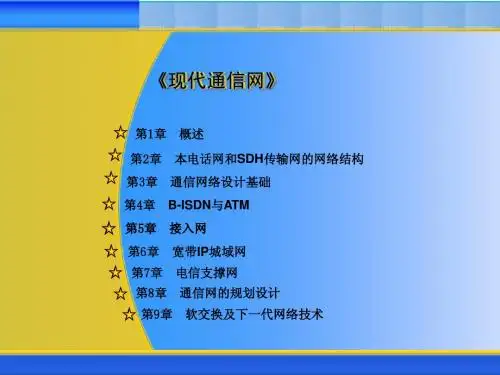

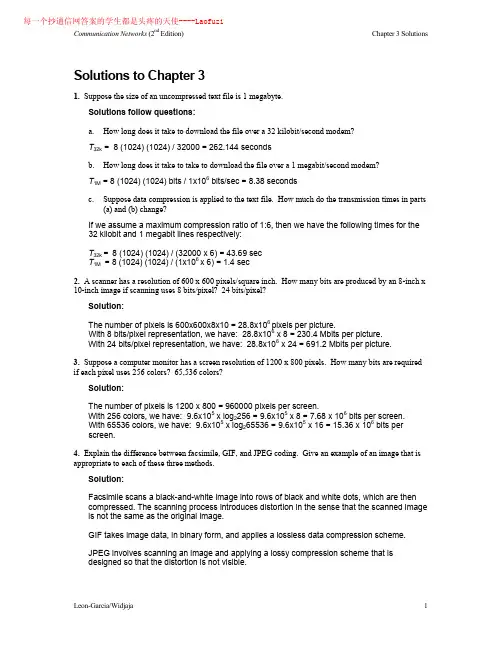
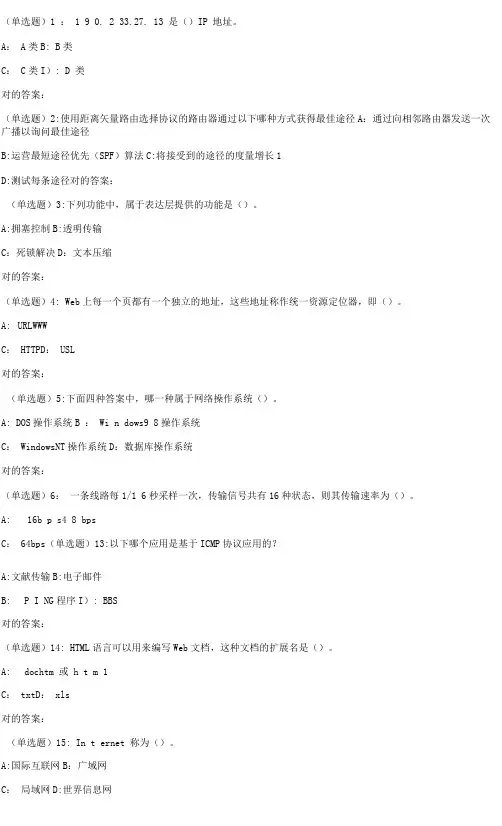
(单选题)1 : 1 9 0. 2 33.27. 13 是()IP 地址。
A: A类B: B类C: C类I): D 类对的答案:(单选题)2:使用距离矢量路由选择协议的路由器通过以下哪种方式获得最佳途径A:通过向相邻路由器发送一次广播以询问最佳途径B:运营最短途径优先(SPF)算法C:将接受到的途径的度量增长1D:测试每条途径对的答案:(单选题)3:下列功能中,属于表达层提供的功能是()。
A:拥塞控制B:透明传输C:死锁解决D:文本压缩对的答案:(单选题)4: Web上每一个页都有一个独立的地址,这些地址称作统一资源定位器,即()。
A:URLWWWC: HTTPD: USL对的答案:(单选题)5:下面四种答案中,哪一种属于网络操作系统()。
A: DOS操作系统B : Wi n dows9 8操作系统C: WindowsNT操作系统D:数据库操作系统对的答案:(单选题)6:一条线路每1/1 6秒采样一次,传输信号共有16种状态,则其传输速率为()。
A:16b p s4 8 bpsC: 64bps(单选题)13:以下哪个应用是基于ICMP协议应用的?A:文献传输B:电子邮件B:P I NG程序I): BBS对的答案:(单选题)14: HTML语言可以用来编写Web文档,这种文档的扩展名是()。
A:dochtm 或 h t m 1C: txtD: xls对的答案:(单选题)15: In t ernet 称为()。
A:国际互联网B:广域网C:局域网D:世界信息网对的答案:(单选题)16:()是实现数字信号和模拟信号转换的设备。
A:网卡B:调制解调器C:网络线D:都不是对的答案:(单选题)17:主机甲与主机乙之间已建立一个TCP连接,主机甲向主机乙发送了两个连续的TCP段,分别包含300字节和500字节的有效载荷,第•个段的序列号为20 0,主机乙对的接受两个段后,发送给主机甲的确认序列号是()。
A: 500B : 700C: 800I): 1000对的答案:D: 256bps对的答案:(单选题)7:接受端不仅能发现差错,并且能拟定差错发生的位置从而加以纠正的差错控制方法为()。
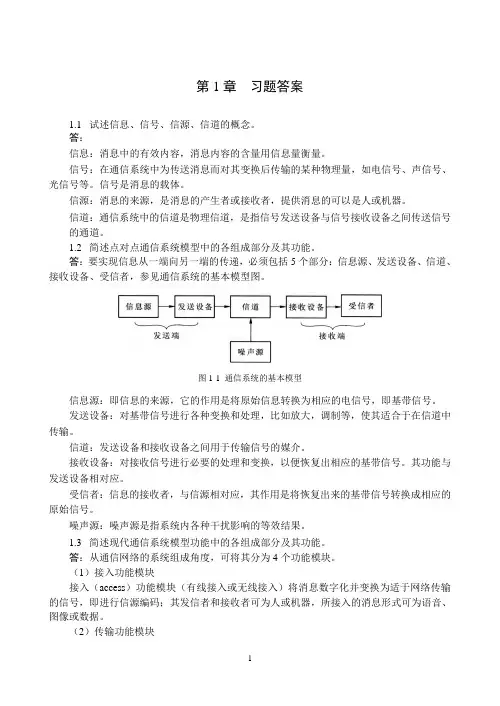
第1章习题答案1.1试述信息、信号、信源、信道的概念。
答:信息:消息中的有效内容,消息内容的含量用信息量衡量。
信号:在通信系统中为传送消息而对其变换后传输的某种物理量,如电信号、声信号、光信号等。
信号是消息的载体。
信源:消息的来源,是消息的产生者或接收者,提供消息的可以是人或机器。
信道:通信系统中的信道是物理信道,是指信号发送设备与信号接收设备之间传送信号的通道。
1.2简述点对点通信系统模型中的各组成部分及其功能。
答:要实现信息从一端向另一端的传递,必须包括5个部分:信息源、发送设备、信道、接收设备、受信者,参见通信系统的基本模型图。
图1-1 通信系统的基本模型信息源:即信息的来源,它的作用是将原始信息转换为相应的电信号,即基带信号。
发送设备:对基带信号进行各种变换和处理,比如放大,调制等,使其适合于在信道中传输。
信道:发送设备和接收设备之间用于传输信号的媒介。
接收设备:对接收信号进行必要的处理和变换,以便恢复出相应的基带信号。
其功能与发送设备相对应。
受信者:信息的接收者,与信源相对应,其作用是将恢复出来的基带信号转换成相应的原始信号。
噪声源:噪声源是指系统内各种干扰影响的等效结果。
1.3简述现代通信系统模型功能中的各组成部分及其功能。
答:从通信网络的系统组成角度,可将其分为4个功能模块。
(1)接入功能模块接入(access)功能模块(有线接入或无线接入)将消息数字化并变换为适于网络传输的信号,即进行信源编码;其发信者和接收者可为人或机器,所接入的消息形式可为语音、图像或数据。
(2)传输功能模块传输(transmission)功能模块(有线传输或无线传输)将接入的信号进行信道编码和调制,变为适于传输的信号形式,并满足信号传输要求的可靠性指标。
(3)控制功能模块控制(control)功能模块由信令网、交换设备和路由器等组成,完成用户的鉴权、计费与保密,并满足用户对通信的质量指标要求。
(4)应用功能模块应用(application)功能模块为网络运营商提供业务经营,包括智能网业务、话音、音视频的各种服务以及娱乐、游戏、短信、移动计算、定位信息和资源共享等。
Solutions to Chapter 2 (Note: solution to Problem 62 to be added)1. Explain how the notion of layering and internetworking make the rapid growth of applications such as the World Wide Web possible.Solution:Internetworking allows many component networks each with different underlying technology and operation to work together and form one large network. As new network technologies are introduced they can be readily incorporated into the Internet. This provides the ubiquitous connectivity for applications like WWW.The layering concept hides the specific underlying network technology from the upper layers and provides a common networking platform. Using the communication service provided by the layers below, new applications can be introduced independently and at a rapid rate.2. (a) What universal set of communication services is provided by TCP/IP?Solution:The TCP/IP protocol stack provides two basic types of communications services through its two transport layer protocols: TCP provides reliable connection-oriented transfer of a byte stream; UDP provides for best-effort connectionless transfer of individual messages. TCP/IP provides withglobally unique logical addressing that enables machines connected to the Internet to access these two services. The IP addressing scheme is very scalable because of its hierarchical structure.2. (b)How is independence from underlying network technologies achieved?Solution:The two basic communications services provided by TCP and UDP are built on the connectionless packet transfer service provided by the Internet Protocol (IP). Many network interfaces are defined tosupport IP. The salient part of the above figure is that all of the higher layer protocols access the network interfaces through IP. This is what provides the ability to operate over multiple networks.2. (c) What economies of scale result from (a) and (b)?Solution:Once a network interface for IP is defined for a given network technology, then hosts connected using the given network technology can connect to the Internet. This allows the reach of the Internet to grow rapidly, leveraging multiple coexisting networks technologies. Thus investment in new network technologies extends the reach of the Internet.3. What difference does it make to the network layer if the underlying data link layer provides a connection-oriented service versus a connectionless service?Solution:If the data link layer provides a connection-oriented service to the network layer, then the network layer must precede all transfer of information with a connection setup procedure. If the connection-oriented service includes assurances that frames of information are transferred correctly and insequence by the data link layer, the network layer can then assume that the packets it sends to its neighbor traverse an error-free pipe.On the other hand, if the data link layer is connectionless, then each frame is sent independently through the data link, probably in unconfirmed manner (without acknowledgments orretransmissions). In this case the network layer cannot make assumptions about the sequencing or correctness of the packets it exchanges with its neighbors.The Ethernet local area network provides an example of connectionless transfer of data link frames.The transfer of frames using "Type 2" service in Logical Link Control (discussed in Chapter 6)provides a connection-oriented data link control example.4. Suppose transmission channels become virtually error-free. Is the data link layer still needed?Solution:The data link layer is still needed for framing the data and for flow control over the transmissionchannel. In a multiple access medium such as a LAN, the data link layer is required to coordinate access to the shared medium among the multiple users.5. Why is the transport layer not present inside the network?Solution:Some of the functions provided by the transport layer can be provided inside the networks, but other functions cannot. For example, the transport layer provides functions at the end-system tocompensate for the limitations and impairments of the network layer, in order to meet requirements(e.g. QoS) of the upper layer. For example in TCP/IP, IP provides only best effort service. To providethe reliable service required by some applications - that is, to compensate for the shortcomings of best effort service - TCP establishes connections and implements error control on an end-to-end basis. One can imagine that a service provider could incorporate this error control function at the edge of its network. On the other hand, one of the main purposes of the transport layer is to allow multiple processes in the end systems to share a network service. This cannot be achieved inside the network.6. Which OSI layer is responsible for the following?(a)Determining the best path to route packets.The network layer is concerned with the selection of paths across the network.(b)Providing end-to-end communications with reliable service.The transport layer is concerned with providing reliable service on an end-to-end basis across the network.(c)Providing node-to-node communications with reliable service.The data link layer provides for the reliable transfer of information between adjacent nodes in anetwork.7. Should connection establishment be a confirmed service or an unconfirmed service? What about data transfer in a connection-oriented service? Connection release?Solution:In general, the establishment of a connection needs to be confirmed before information transfer can commence across a connection. Therefore connection establishment should be a confirmed service.A connection-oriented service is usually reliable so confirmation of data delivery is not necessary. Incertain situations, however, it is possible that the transfer across a connection is not reliable; in this case confirmation of correct data transfer may be required.In general it is desirable that the release of a connection be confirmed by the parties involved. We will see in Chapter 8, section 5, that sometimes it is not easy to confirm that a connection has beenclosed. Consequently, many protocols attempt to confirm the closing of a connection several times, and then give up and simply stop transmitting.8. Does it make sense for a network to provide a confirmed, connectionless packet transfer service?Solution:Yes. Connectionless packet transfer is often unreliable, that is, packets may be lost or discarded inside a network. Certain applications, for example, signaling in connection setup, requireconfirmation to acknowledge the receipt of packets.9. Explain how the notion of multiplexing can be applied at the data link, network, and transport layers. Draw afigure that shows the flow of PDUs in each multiplexing scheme.Solution:Transport Layer: Multiple application layers processes can share the service provided by UDP.When a UDP PDU arrives from the network layer, the destination port number in the PDU is used to deliver the SDU to the appropriate application layer process. Multiple application layer processes also share the service provided by TCP. In this case, when a TCP segment arrives, the TCPconnection ID, consisting of (source port #, source IP address, destination port #, destination IP address), is used to determine which application process to deliver the SDU to.Network Layer: The packet transfer service provided by IP can be used by all transport layersoperating in a machine. Each transfer layer passes SDUs to the IP layer which prepares IP packets with appropriate source and destination IP addresses for transfer across the Internet. Upon receiving an IP packet, a machine examines the protocol type field to determine which transport layer service to deliver the SDU to. We can also view all transport layer PDUs as sharing the IP packet transfer service between a source machine and a destination machine.Data Link Layer: Network layer packets from different protocols (IP, IPX, Appletalk, etc) can share a data link (such as PPP or Ethernet). We can also view packet flows that traverse a data linkbetween two routers as sharing the link.10. Give two features that the data link layer and transport layer have in common. Give two features in which they differ. Hint: Compare what can go wrong to the PDUs that are handled by these layers.Solution:Features they have in common:•Both layers can provide recovery from transmission errors.•Both layers can provide flow control.•Both layers can support multiplexing.Features in which they differ:•The transport layer is end to end and involves the interaction of peer processes across the network. The data link layer involves the interaction of peer-to-peer processes that areconnected directly. In general, the time that elapses in traversing a data link is much smaller than the time traversing a network, where packets can become trapped in temporary routing loops.Consequently, transport layer protocols must be able to deal with out-of-sequence PDUs and amuch larger backlog of PDUs than data link layers.•The data link layer is concerned with framing and the transport layer is not.•The data link layer may be concerned with medium access control, the transport layer does not have this concern.11(a). Can a connection-oriented, reliable message transfer service be provided across a connectionless packet network? Explain.Solution:Yes. To provide a connection-oriented service, the transport layer can establish a logical connection across the connectionless packet network by setting up state information (for example, packetsequence number) at the end systems. During the connection setup, the message is broken into separate packets, and each packet is assigned a sequence number.Using the sequence numbers, the end-system transport-layer entities can acknowledge received packets, determine and retransmit lost packets, delete duplicate packets, and rearrange out-of-order packets. The original message is reassembled as packets arrive at the receiving end.For example, TCP provides a connection-oriented reliable transfer service over IP, a connectionless packet transfer service.11b. Can a connectionless datagram transfer service be provided across a connection-oriented network?Solution:Yes. The connectionless datagram transfer service can be implemented by simply setting up aconnection across the network each time a datagram needs to be transferred. Alternatively, all nodes can have permanent connections to a “connectionless server” that has the function of relayingdatagrams in connectionless fashion.12. An internet path between two hosts involves a hop across network A, a packet-switching network, to a router and then another hop across packet-switching network B. Suppose that packet switching network A carries the packet between the first host and the router over a two-hop path involving one intermediate packet switch. Suppose also that the second network is an Ethernet LAN. Sketch the sequence of IP and non-IP packets and frames that are generated as an IP packet goes from host 1 to host 2.Solution:The IP layer in Host 1 generates an IP packet addressed to the destination host on the destination network and sends it to the router. The network interface in the host encapsulates the IP packet into the packet PDU used by network A. This packet is encapsulated in a frame that traverses data link 1 to the packet switch. The packet is recovered and then forwarded inside a frame along data link 2.The data link at the router recovers the Network A packet, and the IP network interface at the router recovers the IP packet and determines that the next hop is on Network B. The router encapsulates the IP packet into an Ethernet frame, puts the host 2 Ethernet physical address in the frame and sends it to the LAN. The Ethernet card on the host captures the frame and extracts the IP packet and passes it to the host.13. Does Ethernet provide connection-oriented or connectionless service?Solution:Ethernet provides connectionless transfer service of information frames.14. Ethernet is a LAN so it is placed in the data link layer of the OSI reference model.(a)How is the transfer of frames in Ethernet similar to the transfer of frames across a wire? How is itdifferent?The transfer of frames in Ethernet occurs directly over a transmission medium and in this sense is similar to direct transmission over a wire. The sequence of frames into Ethernet arrive in thesame order they are transmitted. However multiple stations can transmit in Ethernet which differs from direct transmission over a wire.(b)How is the transfer of frames in Ethernet similar to the transfer of frames in a packet-switching network?How is it different?Ethernet supports the transfer of frames among multiple end systems and in this sense is similar to a packet switching network. Ethernet does not involve routing which is a feature of packetswitching. Ethernet depends on broadcasting and/or bridging which differs from packet networks.15. Suppose that a group of workstations is connected to an Ethernet LAN. If the workstations communicate only with each other, does it make sense to use IP in the workstations? Should the workstations run TCP directly over Ethernet? How is addressing handled?Solution:Ethernet supports the exchange of frames between stations and can support the direct exchange of information. Using Ethernet without IP would result in an inflexible and difficult to managesystem. Ethernet addresses are fixed and tables need to be changed whenever a machine ismoved, while IP addresses are logical and can be changed whenever a machine is moved. ATCP connection uses the IP addresses in its connection ID so Ethernet addresses could not beused.16. Suppose two Ethernet LANs are interconnected by a box that operates as follows. The box has a table that tells it the physical addresses of the machines in each LAN. The box listens to frame transmissions on each LAN. If a frame is destined to a station at the other LAN, the box retransmits the frame onto the other LAN, otherwise the box does nothing.Solutions follow questions:a.Is the resulting network still a LAN? Does it belong in the data link layer or the network layer?The resulting network is a local area network that has been extended. The extended LAN transfers frames, and so it still belongs in the data link layer.b.Can the approach be extended to connect more than two LANs? If so, what problems arise as the number ofLANs becomes large?Yes, more than two LANs can be connected using the above approach to form an extended LAN. As the number of LANs becomes large, the number of physical addresses stored in the bridge grows and becomes unmanageable. Each time a machine is added the addresses in all the boxes need to be updated. Serious problems arise if boxes are connected so that loops can occur.17. Suppose all laptops in a large city are to communicate using radio transmissions from a high antenna tower. Is the data link layer or network layer more appropriate for this situation?Solution:The data link layer is concerned with the transfer of frames of information across a single hop. The network layer involves the transfer of information across a network using multiple hops per path in general. The connection from a radio antenna to the laptops is direct, and thus a data link layerprotocol is more suitable for this situation.Now suppose the city is covered by a large number of small antennas covering smaller areas. Which layer is more appropriate?A number of areas each covered by small antennas can be interconnected using the "bridging"approach of problem 16, which remains in the data link layer. However, the network layer may be more appropriate because it provides for the transfer of data in the form of packets across thecommunication network. A key aspect of this transfer is the routing of the packets from the source machine to the destination machine, typically traversing a number of transmission link and network nodes where routing is carried out.18. Suppose that a host is connected to a connection-oriented packet-switching network and that it transmits a packet to a server along a path that traverses two packet switches. Suppose that each hop in the path involves a point-to-point link, that is, a wire. Show the sequence of network layer and data link layer PDUs that are generated as the packet travels from the host to the server.Solution:Assume that a network connection has already been set up between the host machine and thenetwork machine. When the host generates an IP packet for transfer to the server, the IP packet will be transferred using the network connection as follows.•The IP packet is encapsulated into a network packet that has a connection ID in its header.The packet may then be encapsulated into a frame that traverses data link 1 and arrives atswitch 1.•The network packet is recovered from the data link 1 frame. The connection ID in the packet is used to determine the outgoing port from switch 1. The connection ID may need to bemapped into a corresponding connection ID over data link 2. The packet is encapsulated intoa frame that traverses data link 2.•The network packet is recovered from the data link 2 frame. The connection ID in the packet determines the outgoing port from switch 1 and the next connection ID. The packet isencapsulated into a frame that traverses data link 3.•The network packet is recovered from the data link 3 frame. The connection ID in the arriving packet indicates that this is the destination node. The IP packet is recovered.The connection-oriented network in this example could correspond to ATM or to frame relay.19. Suppose an application layer entity wants to send an L-byte message to its peer process, using an existing TCP connection. The TCP segment consists of the message plus 20 bytes of header. The segment is encapsulated into an IP packet that has an additional 20 bytes of header. The IP packet in turn goes inside an Ethernet frame that has 18 bytes of header and trailer. What percentage of the transmitted bits in the physical layer correspond to message information, if L = 100 bytes, 500 bytes, 1000 bytes?Solution:TCP/IP over Ethernet allows data frames with a payload size up to 1460 bytes. Therefore, L = 100, 500 and 1000 bytes are within this limit.The message overhead includes:•TCP: 20 bytes of header•IP: 20 bytes of header•Ethernet: total 18 bytes of header and trailer.ThereforeL = 100 bytes, 100/158 = 63% efficiency.L = 500 bytes, 500/558 = 90% efficiency.L = 1000 bytes, 1000/1058 = 95% efficiency.20. Suppose that the TCP entity receives a 1.5 megabyte file from the application layer and that the IP layer is willing to carry blocks of maximum size 1500 bytes. Calculate the amount of overhead incurred from segmenting the file into packet-sized units.Solution:1500 - 20 -20 = 1460 bytes1.5 Mbyte / 1460 byte = 1027.4, therefore 1028 blocks are needed to transfer the file.Overhead = ((1028 x 1500 - 1.5M)/1.5M) x 100 = 2.8%21. Suppose a TCP entity receives a digital voice stream from the application layer. The voice stream arrives at a rate of 8000 bytes/second. Suppose that TCP arranges bytes into block sizes that result in a total TCP and IP header overhead of 50 percent. How much delay is incurred by the first byte in each block?Solution:Assume the stream is segmented as shown below, where the white cells represent data and the shaded cells represent the TCP header overhead.Therefore, block size = 80 bytes and the payload size = 40 bytes.Assume zero processing delay due to data arrangement and segmenting.The delay incurred by the first byte of each block = 40/8000 = 0.5 ms.22. How does the network layer in a connection-oriented packet-switching network differ from the network layer ina connectionless packet-switching network?Solution:The network layer in connection-oriented networks maintains state information about everyconnection. It can allocate resources at the switches through admission control. The network layer in connectionless networks has no knowledge of "connections", and instead deals independently with each packet.The network layer in connection-oriented networks performs routing on a per connection basis. Each packet is routed based on a connection identifier of some sort and packets of the same connection have the same identifier value. In a connectionless network, routing is performed on per packet basis;each packet is routed independently based on information carried in the packet header, for example, the destination address.In connection-oriented networks, the network layer forwarding table is set up by a signaling procedure during the connection establishment. In connectionless networks, the routers may execute adistributed algorithm to share network state information and dynamically calculate the routing table continuously.In case of failure, the connection must be re-established in connection-oriented networks, whereas in connectionless networks, the packets are re-routed. The network layer in connectionless networks is more robust against failures.Summary of differences:Connection-oriented Connectionless Maintain state information about every connection No knowledge of the "connection"Allocate resources to connections at switches No resource allocationAdmission control No admission controlPer connection routing Per packet routingRoute packet based on identifier Route packet based on destination address.Forwarding table specifies the output port and outgoing identifier value as function of the incoming identifier value Routing table specifies the output port depending on the destination addressForwarding table set up by signaling during connection establishment.Router executes distributed algorithm to share network state information and dynamically calculate the routing tableConnection must be re-established in cases of failure Packets are rerouted around failures, robust against failures23. Identify session layer and presentation layer functions in the HTTP protocol.Solution:Presentation layer functions:The request message and the response message headers include information about the content type of the documents (e.g. text/html, image/gif).Session layer functions:The HTTP protocol defines the client/server interaction in three steps:1. Client sends the request for a file2. Server replies with the file or error message if file is not found.3. Server closes the TCP connection after some timeout period.24. Suppose we need a communication service to transmit real-time voice over the Internet. What features of TCP and what features of UDP are appropriate?Solution:TCP is desirable in that it provides a connection for the transfer of a stream of information, which characterizes a digital voice stream. However, to provide reliable service TCP uses acknowledgments and retransmissions that result in packet delay and jitter that can not be tolerated by real-time traffic.UDP provides connectionless service and delivers packets quickly. In case of packet loss, UDP does not provide retransmission, but some degree of packet loss can be tolerated by voice.25. Consider the end-to-end IP packet transfer examples in Figure 2.15. Sketch the sequences of IP packets and Ethernet and PPP frames that are generated by the three examples of packet transfers: from the workstation to the server; from the server to the PC, and from the PC to the server. Include all relevant header information in the sketch.Solution:Workstation to Server:IP packet headerEthernet FrameThe Ethernet frame is broadcast over the LAN. The server's NIC card recognizes that the frame is intended for its host, so it captures the frame and examines it. It finds that the protocol type is set to IP, so it passes the IP datagram up to the IP entity.Server to PC:IP packet headerEthernet FrameThe Ethernet frame is broadcast over the LAN. The router examines frame and passes IPdatagram to its IP entity which discover that the IP datagram is not for itself, but is to be routed on. The routing tables at the router show that the machine with address (2,2) is connecteddirectly on the other side of the point-to-point link. The router encapsulates the IP datagram in a PPP frame.IP packet headerPPP FrameThe PPP receiver at the PC receives the frame, checks the protocol type field and passes the IP datagram to its IP entity.PC to Server:The PC IP entity generates the IP packet shown below. The PPP transmitter at the PC encapsulates the IP packet into a PPP frame sends it to the point-to-point link. There's no need for a physical address specificationIP datagramIP packet headerPPP FrameThe router examines the PPP frame and passes the IP datagram to its IP entity which discoversthat the IP datagram is not for itself, but is to be routed on. The routing table at the router showsthat the machine with address (1,1) is connected in the other side of the Ethernet network. Therouter then encapsulates the IP datagram into an Ethernet frame that is broadcast in the LAN.The server's NIC card recognizes that the frame is intended for its host, so it captures the frameand examines it. It finds that the protocol type is set to IP, so it passes the IP datagram up to the IP entity.26. Suppose a user has two browser applications active at the same time, and suppose that the two applications are accessing the same server to retrieve HTTP documents at the same time. How does the server tell the difference between the two applications?Solution:A client application generates an ephemeral port number for every TCP connection it sets up. AnHTTP request connection is uniquely specified by the five parameters: (TCP, client IP address,ephemeral port #, server IP address, 80). The two applications in the above situations will havedifferent ephemeral port #s and will thus be distinguishable to the server.27. Consider the operation of non-persistent HTTP and persistent HTTP.(a)In non-persistent HTTP (version 1.0): Each client-server interaction involves setting up a TCP connection,carrying out the HTTP exchange, and closing the TCP connection. Let T be the time that elapses fromwhen a packet is sent from client to server to when the response is received. Find the rate at which HTTPexchanges can be made using non-persistent HTTP.(b)In persistent HTTP (version 1.1) the TCP connection is kept alive. Find the rate at which HTTP exchangescan be made if the client cannot send an additional request until it receives a response for each request.(c)Repeat part (b) if the client is allowed to pipeline requests, that is, it does not have to wait for a responsebefore sending a new request.Solution:(a) Each HTTP exchange involves: 1. a three-way handshake to set up the TCP connection; 2. anHTTP request-response interaction; and 3. a TCP close. The client can send its request after the first two handshakes in part 1 (which takes up T seconds). The request and response then take an additional T second. A new request can be initiated with an associated new TCP connection even while the previous TCP connection is being closes. Thus a maximum of one HTTP exchange per 2T seconds is possible.(b) Since each exchange is completed in T seconds, after the connection is setup, the exchange rateis 1/T.(c) The rate depends on how long it takes to send a request and how late it takes to compose aresponse. Considering the maximum of these to be t seconds, exchange rate can be up to 1/t.28. What is the difference between a physical address, a network address, and a domain name?Solution:The physical address is the unique hardware address that identifies an interface of a machine on a physical network such as a LAN. Physical addresses are used in the data link layer.A network address is a machine's logical address on a network. The network address is used in thenetwork layer. The network address used on the Internet is the IP address.Domain names are used as an aid to identify hosts and networks in the Internet, since names are easier to remember than numbers. The DNS system is used to translate between domain names and IP addresses. The domain name for the network address 128.100.132.30 is .29. Explain how a DNS query proceeds if the local name server does not have the IP address for a given host when the following approaches are used. Assume an example where four machines are involved in ultimately resolving a given query.(a)When a machine B cannot resolve an address in response to a query from A, machine B sends the query toanother machine in the chain. When B receives the response, it forwards the result to B.(b)When a machine B cannot resolve an address in response to a query from A, machine B sends a DNS replyto A with the IP address of the next machine in the chain, and machine A contacts that machine.Solution:(a) Host A sends a query to a name server B. B cannot resolve an address, therefore sends the queryto C. C cannot resolve an address either, and send the query to D. Similarly, D cannot resolve an address and sends the query to E, where finally an address is resolved and returned to D. D replies the address to C, C replies it to B, and finally B passes it to the host. In this scenario each server should remember the state of the query and its source.(b) Host A sends a query to name server B. B cannot resolve an address, replies to A with the IPaddress of C. Host A send a query to C this time. C cannot resolve an address, and replies to A with the IP address of D. A sends a query to D. D cannot resolve an address, and replies with the IP address of E. A sends a query to E, E finally resolves an address and returns it to A. In this scenario。
1、下列设备属于资源子网的是A.交换机B.集中器C.路由器D.打印机正确答案:D2、计算机网络中可共享的资源包括()A.硬件、软件、数据和通信信道B.主机、外设和数据C.主机、外设和通信信道D.硬件、软件和数据正确答案:A3、计算机网络最突出的特点是()A.运算精度高B.资源共享C.运算速度快D.内存容量大正确答案:B4、构成计算机网络的要素主要有:通信主体、通信设备和通信协议,其中通信主体指的是()A.网卡B.计算机C.交换机正确答案:B5、所有站点均连接到公共传输媒体上的网络结构是()A.树型B.总线型C.环型D.混合型正确答案:B6、完成通信线路的设置与拆除的通信设备是()A.通信控制器B.线路控制器C.调制解调器D.多路复用器正确答案:A7、在星型局域网结构中,连接文件服务器与工作站的设备是()A.路由器B.集线器或者交换器C.调制解调器D.网桥正确答案:B8、下列对网络拓扑结构描述正确的有()A.在星型结构的网络中,可以采用集中式访问控制策略和分布式访问控制策略B.总线型网络一般采用CSMA/CD介质访问控制协议C.典型的环形网络有Token-RingD.环形网络的主要缺点是链路的可靠性问题正确答案:B9、OSI/RM产生之后开始的计算机网络称为()A.第四代计算机网络B.第二代计算机网络C.第一代计算机网络D.第三代计算机网络正确答案:D10、下列网络属于局域网的是()A.中国教育网B.因特网C.南京热线D.南京理工大学校园网正确答案:D二、判断题1、目前实际存在与使用的广域网基本都采用网状拓扑。
(√)2、用来把用户接入到因特网的网络称为接入网 AN,它又称为本地接入网或居民接入网。
(√)三、填空题1、树型拓扑结构是_____拓扑结构的一种复杂变体正确答案:星型2、计算机网络拓扑主要是指_____子网的拓扑构型,它对网络性能、系统可靠性与通信费用都有重大影响正确答案:通信3、局域网英文缩写是_____正确答案:LAN。
北京邮电大学高等函授教育、远程教育《现代通信网》综合练习题与答案第一部分练习题一、填空题1、通信网的硬件构成要素有_终端设备_、_传输链路_与_交换设备_ 。
2、通信网按服务范围可分为_本地网、_长途网与_国际网。
3、通信网的基本结构有_网形、星形、复合形、总线形、_环形、树形与_线形。
4、支撑网包括_信令网、同步网与管理网。
5、业务网即用户信息网,按功能又可分为用户接入网、交换网与传输网三部分。
6、网的接续质量通常用接续损失与接续时延来衡量。
7、本地网的类型有特大与大城市本地网与中等城市本地网。
8、本地网的网络结构有_网形网与_二级网_两种。
9、路由按呼损分有_高效路由_与_低呼损路由两种。
10、路由选择结构有_有级选路结构_与_无级选路结构_两种。
11、SDH的基本网络单元有_终端复用器、_分插复用器与_数字交叉连接设备。
12、现阶段我国SDH传输网分为四个层面,分别是省际干线层面、省内干线层面、中继网层面与用户接入网层面。
13、点线图中点的度数是与之关联的边的个数_。
14、点线图中的路径是__无重复边的链路__。
15、正则图是所有点的度数相等__。
16、树的定义是无回路的连通图,只有连通图才有支撑树。
17、具有n个点的树共有n-1个树枝。
18、B-ISDN业务可分为两大类,分别是交互型业务与分配型业务。
19、ATM的信息单元叫做信元,固定长度为53字节,其中信头为5字节。
20、B-ISDN的用户-网络接口配置中,U B接口的标准速率为155Mbit/s与622Mbit/s。
21、ATM交换包括_ VP交换_与__ VC交换_。
22、ATM交换的缓冲排队方式有_输入缓冲排队方式_、输出缓冲排队方式与_中央缓冲排队方式_。
23、接入网的三种主要接口类型是用户网络接口、业务节点接口与维护管理接口。
24、利用分层模型可以将接入网的传送网划分为电路层、传送通道层与_传输媒介层_三个层次。
25、业务节点接口主要有两种,其一是_模拟接口(Z接口)_,其二是__数字接口(V5接口)_。
一|、填空题1.通信网在硬件设备方面的构成要素是(终端设备)、(传输链路)和(交换设备),其中(交换设备)是构成通信网的核心要素。
2.通信网的基本结构主要有(网形)、(星形)、(复合形)、(总线形)、(环形)、(线形)和(树形)。
5.业务网是通信网的主体,按其功能可分为(用户接入网)、(交换网)和(传输网)三个部分。
6.支撑网包括(信令网)、(同步网)、(管理网)。
7.就工作范围而言,ISDN具有不同的信令,分别是(用户—网络信令)、(网络内部信令)和(用户—用户信令)。
P1778.ISDN模型是一个立体的,由三个分别对应着不同类型的信息的三个平面组成,这三个平面分别是:(用户平面U )、(控制平面C )和(管理平面M )。
9.ATM的信息单元叫做信元,固定长度为(53 )字节,其中信头为( 5 )字节。
P23310.ATM层的核心功能是用户设备(信头的产生和提取,信元的复接与分接),网络节点(通过信头变换,实现VP与VC的交换)11.ATM系统执行的基本功能为:(信头变换)(路由选择)(排队)12.ATM交换的缓冲排队方式有:(输入缓冲方式)(输出缓冲方式)(中央缓冲方式)13.目前数字网的同步方式主要有(准同步)、(互同步)和(主从同步)。
14.现代电信网按功能分为(电信业务网)(电信支撑网)15.支撑网包括(数字同步网)(No.7信令网)和(电信管理网)。
P38616.TMN构成:由(操作系统(OS))(工作站(WS))(数据通信网(DCN))(网元(NE))17.国际电信联盟从功能模块、信息交互、物理实现三个不同侧面定义了TMN的体系结构分别是(功能体系结构)(信息体系结构)(物理体系结构)18.TMN的管理层次有(事物管理层)、(业务管理层)、(网路管理层)和(网元管理层)四个层次。
19.ADSL系统将双绞线对上的频谱分为三个,分别是( 高速下行信道)、(中速双工信道)和(普通电话业务信道)。
通信业务发展概述(总分46, 做题时间90分钟)一、单项选择题(每题的备选项中,只有1个最符合题意)1.在我国现行的国民经济体系中,通信业属于第三产业的范畴,其依据的产业划分方法是( )。
A.两部门划分法B.三次产业划分法C.四次产业分类法D.五次产业分类法SSS_SIMPLE_SINA B C D该问题分值: 1答案:B[解析] 本题考查通信业的产业属性。
注意:在三次产业划分法中,通信业属于第三产业。
2.在进行某地区信息化程度调查时,调查人员统计了“每百人在校大学生人数”,该调查内容是信息化指数中的( )指标。
A.信息量B.信息主体水平C.信息系数D.信息装备SSS_SIMPLE_SINA B C D该问题分值: 1答案:B[解析] 本题考查信息化指数。
题中四个选项全部是日本的信息化指标体系中的内容,其中信息主体水平包括第三产业就业人口数和每百人在校大学生人数两个二级指标。
3.网络的外部性有两种类型,其中由于产品使用者的数量增加,使该产品的互补产品价值提高的情形称为( )。
A.直接网络外部性B.负的网络外部性C.网络效应D.间接网络外部性SSS_SIMPLE_SINA B C D该问题分值: 1答案:D[解析] 本题考查的是间接网络外部性的概念。
4.从社会发展进程来看,产业结构的演进遵循由低级向高级发展的规律,其中主导产业的变换历程是( )。
A.农业—工业—建筑业B.第—产业—第二产业—第三产业C.信息源—信息加工—信息传递D.农业—林业—服务业SSS_SIMPLE_SINA B C D该问题分值: 1答案:B[解析] 本题考查的是产业分类的演进,或者说社会生产活动发展的历史顺序。
5.信息产业中不包括( )。
A.电信业B.建筑业C.出版业D.软件业SSS_SIMPLE_SINA B C D该问题分值: 1答案:B[解析] 本题考查产业分类。
建筑业属于第二产业,其他选项都是信息产业包含的内容。
6.对于通信行业来说,在一定的范围内,随着规模的扩大,单位成本呈单调递减,也就是消费者越多、越密集,设施的公用性就( )。
通信网基本概念与主体结构答案每一个抄通信网的学生都是头疼的天使----Laofuzi Communication Networks 2nd Edition Chapter 10 Solutions Solutions to Chapter 10 10.1. Can all traffic in an IntServ router be of guaranteed service type Explain. Solution: All the traffic can be of guaranteed service only if all the flows are shaped and if they strictly comply with the traffic specifications. However in practice the total amount of traffic that can be admitted will have some limit. The reason is that to bound the delay the maximum queue length in the router must be below a certain threshold. If all of the flows are well behaved and without bursts the queue size will always be reasonably small. However if the flows are bursty the queue may grow to levels that can cause large unacceptable delays. To guarantee the delay bounds extra bandwidth should be assigned based to accommodate the burstiness of the flows. This overbooking can sometimes lead to the queue becoming empty and hence result in underutilization of the output link. Thus it is reasonable to fill the output bandwidth during such periods with best effort traffic. So in summary to efficiently utilize the bandwidth and achieve higher throughputs it is necessary to admit best effort traffic alongside guaranteed service traffic. 10.2. Develop a packet-scheduling approach to provide guaranteed service controlled load service and best effort service in a router. Can any mix of these three traffic types be supported Explain. Solution: Separate queues must be provided for the packets from each type of service in order for their packets to be serviced appropriately. The set of queues belonging to guaranteed service should always receive service with a rate R which should be larger than the total guaranteed service traffic. The aggregate rate R is guaranteed and controlled by giving priority to the guaranteed service queues and controlling the service they receive by a leaky bucket shaper with a sustained rate of R. Individual queues within the guaranteed service group are serviced in a round-robin fashion while for each queue its service is controlled by a dedicated leaky bucket shaper with the parameters set based on the requirements of the flow assigned to that queue. The set of controlled load service queues are serviced during the periods that guaranteed service queues are not serviced. The capacity in excess of R is available to controlled load traffic. Flows are assigned to different queues and weighted fair queueing can be used within the group to service the queues depending on their requirements. Best effort traffic is given the lowest priority. The queue is serviced only if the other two sets of queues are empty. 10.3. RSVP signaling is very different from ATM signaling. Discuss the differences and list the advantages and disadvantages of each protocol. Solution: RSVP uses Receiver-Initiated Reservation rather than ATM’s per-hop path request to reserve network resources. RSVP is intended for use with multicasting and is receiver oriented. ATM is designed for unicast traffic and is sender oriented. RSVP receiver-initiated reservation Advantage: interoperates with non-RSVP routers soft state provides robustness with respect to faults requests can be merged reducing the reservation load on the routers. Disadvantage: soft state – requires periodic updates receiver needs to know the path for connection. Leon-Garcia/Widjaja 1每一个抄通信网的学生都是头疼的天使----Laofuzi Communication Networks 2nd Edition Chapter 10 Solutions ATM per-hop path request Advantage: hard state –reserve only once. Disadvantage: Individual VCC is required for each host in multicast application. Source requests the connections so it needs to know the requirements of the receiver. 10.4. Consider the merging of reservations in RSVP. Suppose that there is a single sender and 2n receivers that are reached through a path that consists of a depth n binary tree that has a router located at each node. What is the total number of reservation request messages generated by the receivers Solution: The total number of reservation request messages generated by thereceivers and routers are equivalent to finding the branches of a binary tree with a depth of n. Let Nn be the number of branches in a binary tree with depth n. At level n there 2n new branches and so we have the recursion Nn Nn–1 2n. Draw a picture of a tree to verify this. It is easy to then verify that Nn total number of request messages is 2n1 – 1. 10.5. Suppose RSVP is used to set up a virtual private network to interconnect n users across an Internet. Discuss the appropriateness of the three RSVP reservation styles for this application. RSVP has three reservation styles Wildcard Filter Fixed Filter and Shared Explicit. Wild card filter WF creates a single reservation shared by all senders. It is designed for applications that are unlikely to have multiple senders transmitting simultaneously. It is not appropriate for VPN applications because WF cannot provide the receiver requests if more than one sender is transmitting at the same time. Fixed filter FF creates a distinct reservation for each sender. It is an appropriate solution for VPN requirements. Each sender VPN has its own resource reservation and this resource is shared by number of receivers hosts located in different location belong to the same VPN. Shared explicit SE creates a single reservation shared by a set of explicit senders. It may also be appropriate in VPN applications under certain conditions. The merging of the reservation between senders can result in a more efficient use of network resources. 10.6. Select and justify a choice an RSVP reservation style that is appropriate for the following situations: Solutions follow questions: a A multiuser application where a video stream from each participant must be delivered to every other participant. This situation is a multipoint to multipoint application so the Fixed Filter FF is the appropriate choice. FF creates a distinct reservation for each participant sender and it can merge downstream requests and forward the sum of flow spec upstream. It is an appropriate reservation style because each participant sender will only receive a single reservation request that has been merged by a multiple of other participants. This simplifies the processing overhead for each sender and allows the processing power to focus on accepting multiple video streams for other participants. b An audioconferencing application that is self-limiting in that more than two participants are unlikely to speak simultaneously. This audio conferencing application is best suited with the Wild card Filter WF style. The WF-style is suitable for applications that are unlikely to have multiple senders transmitting simultaneously. In this application the self-limiting feature prevents two participants from speaking simultaneously. Leon-Garcia/Widjaja 2每一个抄通信网的学生都是头疼的天使----Laofuzi Communication Networks 2nd Edition Chapter 10 Solutions c A multiuser application in which each participant must receive explicit permission before transmitting information. The Shared Explicit SE reservation style is best suited for this multiuser application. The SE style creates a single reservation shared by a set of explicit senders. In this application only the participant that receives an explicit permission is allowed to join a single reservation. Any participant that does not receive permission is not allowed to use this single reserved resource.10.7. What information needs to be carried by Resv messages in RSVP to set up guaranteed IP service with a specific bandwidth and a given delay-bound requirement How does a router process this information Solution: The information that must be carried by Resv message in RSVP to set up guaranteed IP service with a specific bandwidth and a given delay bound is: the common header SESSION RSVP_HOP TIME_V ALUES STYLE and Fixed Filter flow descriptor along with flow spec and filter spec. When a router receives this Resv message it reserves the necessary resources based on the flow specification which in turn governs the bandwidth and delay-bound requirements. Next the router exams the filter spec to determine the data packets that correspond to the defined flow spec. 10.8. Discuss the interplay between a QoS routing algorithm RSVP andintegrated services IP. Solution: Integrated services IP provides QoS packet delivery between the source and destination pair. The QoS parameters are dependent on the source requirements for example bandwidth requirement and delay-bound requirement. To provide integrated services it is necessary for the routing protocol network layer to provide QoS routing. QoS routing provides for the selection of paths with specific attributes that can support specified QoS requirements. RSVP provides the means for reserving resources along paths identified by QoS routing. 10.9. Explain how the soft-state feature of RSVP allows it to adapt to failures in the network. Solution: The RSVP soft-state approach requires each node to refresh its reservation periodically by using Path and Resv messages. When a state is not refreshed within a certain time-out period the state is deleted. Upon a link failure within the network a PathErr message is sent to the ingress node source node. The ingress node simply defines a new route by refreshing the Path message to a different next hop. The old failure path will eventually tear down after the timer is expired. This approach provides error recovery upon failure however it is necessary for the ingress node to keep updating the status of the link-state topology and determine the next possible route in case of the primary route fails. 10.10. Discuss whether RSVP provides a scalable means to set up connections to a session that consists of the broadcasting of a given TV program. Solution: Broadcasting a TV program is a point to multipoint multicast application. RSVP does provide a scalable means to set up connections to a session in multicast application. RSVP performs the resource reservation for multicast applications adapting dynamically to changing group membership and changing route. Also RSVP requires the receiver to initiate and maintain the resource reservation rather than obtaining the bandwidth requirement from each receiver. This process avoids an implosion problem and minimizes the processing overhead to the sender. Finally the RSVP routers provide different reservation styles and the requests can merge in several ways according to Leon-Garcia/Widjaja 3每一个抄通信网的学生都是头疼的天使----Laofuzi Communication Networks 2nd Edition Chapter 10 Solutions the reservation style. This prevents duplicate resource reservations if multiple downstream receivers belong to the same multicast group. 10.11. Explain what happens if RSVP is used to set up small-bandwidth flows on a large-bandwidth link How well does RSVP scale in this situation Solution: If RSVP is used to set up small-bandwidth flows on a large-bandwidth link the router will have to update the available resource bandwidth every time there are small-bandwidth flow request for resources. Moreover the router needs to keep track of the available resources and reject resource reservation requests when the available bandwidth cannot support a particular requirement. The router has to keep track of every single flow resource usage during the setup and tear down procedure. All of these activities consume a lot of processing power when the link has large bandwidth being shared by large numbers of small-bandwidth flows. 10.12. Obtain a packet capture file for RSVP either in the lab or downloaded from a web site. Examine the details of Path Resv and refresh messages. Solution: The following text shows the details of the first PATH message for MPLS path setup shown in Figure 2.27. The file is obtained by printing the capture data from Ethereal. We highlight in color the main fields and interesting information. In particular note the explicit route identified in the message and the LABEL REQUEST. The TIME V ALUES field is set to 30000 ms that is 30 second refresh period. Frame 1 306 bytes on wire 306 bytes captured Arrival Time: Feb 10 2000 08:49:03.806994000 Time delta from previous packet: 0.000000000 seconds Time relative to first packet: 0.000000000 seconds Frame Number: 1 Packet Length: 306 bytes Capture Length: 306 bytes Ethernet II Src: 00:90:92:9d:94:01 Dst: 00:d0:63:c3:b8:47 Internet Protocol Src Addr:17.3.3.3 17.3.3.3 Dst Addr: 16.2.2.2 16.2.2.2 Resource ReserVation Protocol RSVP: PATH Message. SESSION: IPv4-LSP Destination 16.2.2.2 Tunnel ID 1 Ext ID 11030303. SENDER TEMPLATE: IPv4-LSP Tunnel Source: 17.3.3.3 LSP ID: 1. RSVP Header. PA TH Message. RSVP Version: 1 Flags: 00 Message Type: PATH Message. 1 Message Checksum: 0xdb58 correct Sending TTL: 254 Message length: 264 SESSION: IPv4-LSP Destination 16.2.2.2 Tunnel ID 1 Ext ID 11030303. Length: 16 Class number: 1 - SESSION object C-type: 7 - IPv4 LSP Destination address: 16.2.2.2 16.2.2.2 Tunnel ID: 1 Extended Tunnel ID: 285410051 17.3.3.3 HOP: IPv4 210.0.0.1 Length: 12 Class number: 3 - HOP object C-type: 1 - IPv4 Neighbor address: 210.0.0.1 Leon-Garcia/Widjaja 4每一个抄通信网的学生都是头疼的天使----Laofuzi Communication Networks 2nd Edition Chapter 10 Solutions Logical interface: 0 TIME V ALUES: 30000 ms Length: 8 Class number: 5 - TIME V ALUES object .。